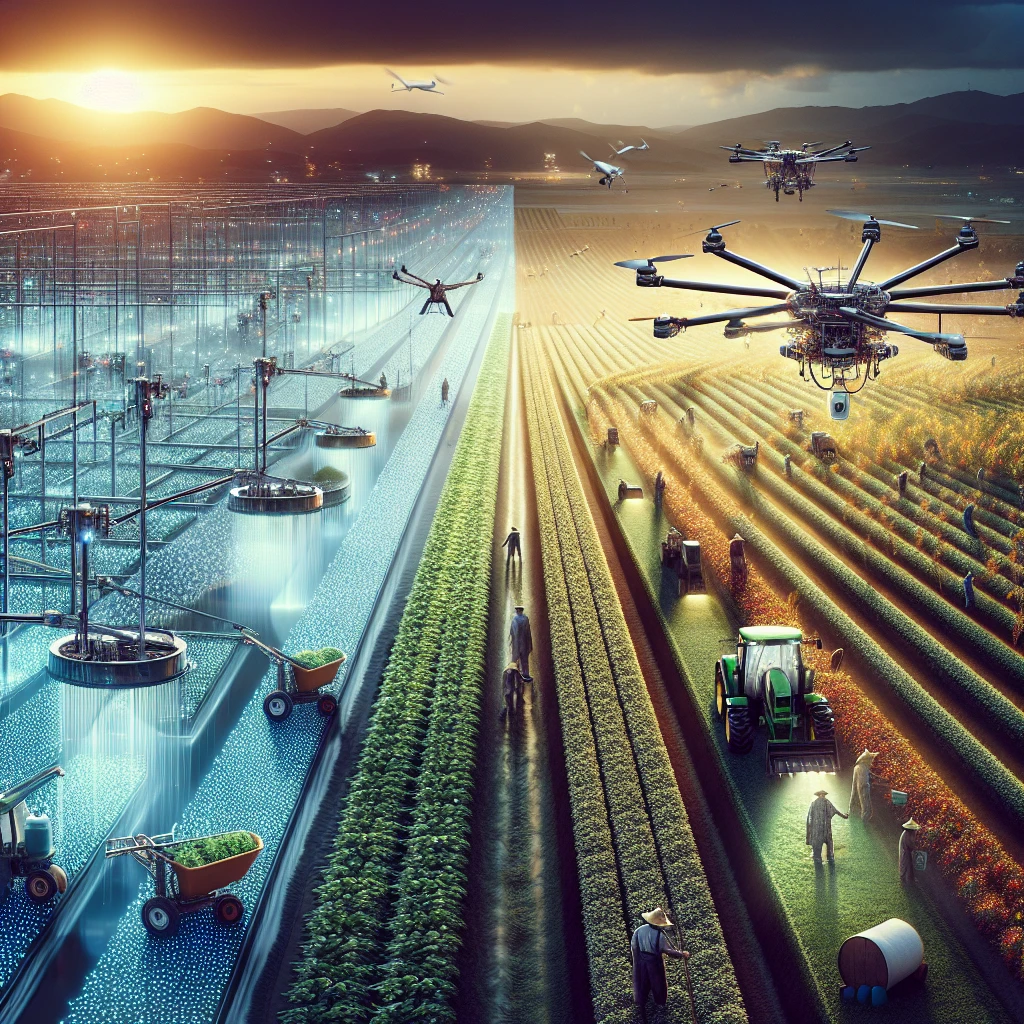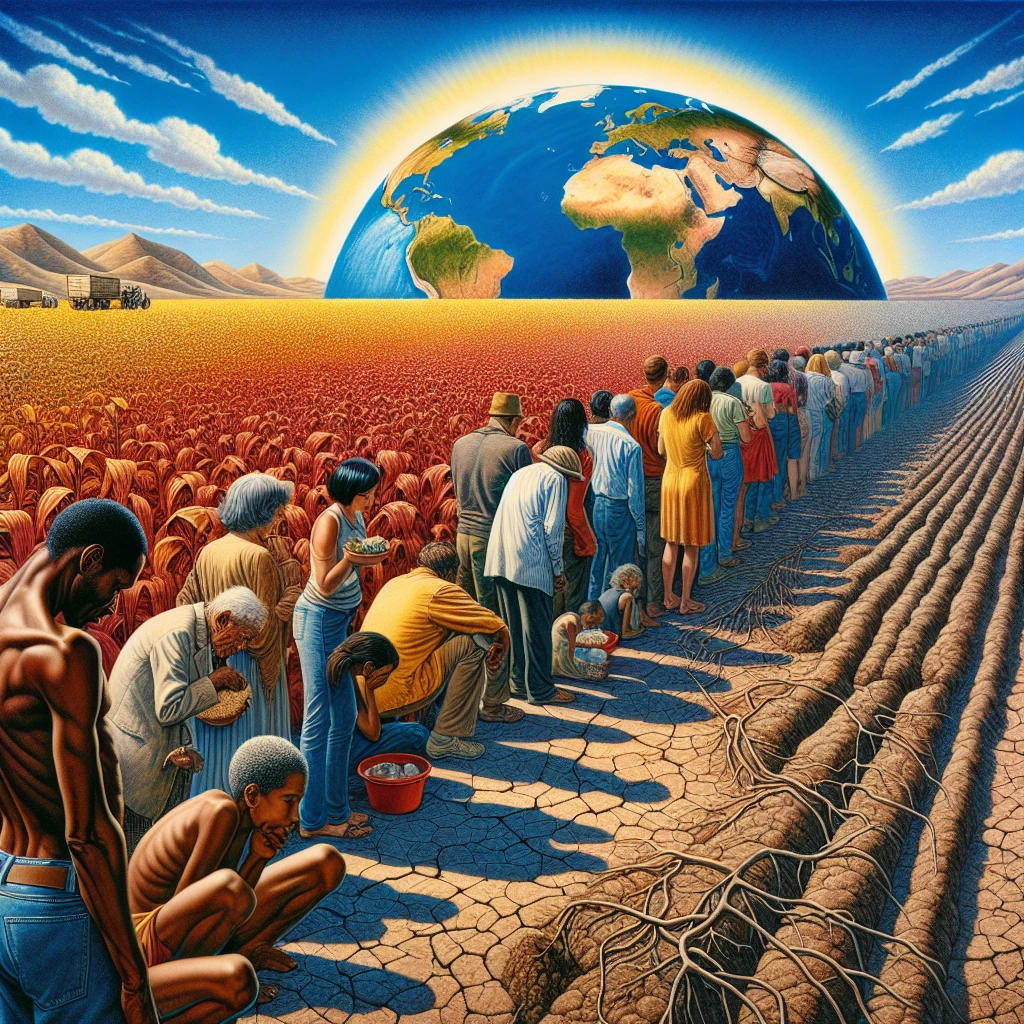

The world is currently facing a global food shortage crisis, with a significant increase in the number of people facing acute food insecurity and requiring urgent food assistance. This crisis has been exacerbated by various factors, including climate change, armed conflict, economic shocks, gender inequality, and food waste.
The situation is further compounded by the impact of the COVID-19 pandemic, which has pushed an additional 122 million people into hunger since 2019.
The main causes of food shortages globally can be attributed to a devastating combination of factors, such as weather extremes, armed conflict, economic shocks, and climate change. These factors have led to a sharp rise in global hunger, destroying lives, crops, and livelihoods, and undermining people’s ability to feed themselves.
In addition to these factors, poverty and the COVID-19 pandemic have also played a significant role in exacerbating the food shortage crisis, leading to an increase in the number of people facing acute food insecurity. Efforts to address these causes are critical in tackling the urgent global food crisis and providing support for vulnerable households at risk of food insecurity.
Check out this Youtube video: “Will there be a global food shortage? – YouTube” to learn about the main causes of food shortages globally and how it could impact our future.
Economic Factors
The impact of poverty on access to food is significant, as low-income households face a higher risk of food insecurity. In 2020, 28.6% of low-income households experienced food insecurity, compared to the national average of 10.5%.
This connection between poverty and food insecurity arises as the incidence of food insecurity rises with a decrease in the income-to-needs ratio. This signifies that poverty has a direct correlation with limited access to food.
Inflation and food price volatility contribute to the challenge of food shortages globally. Volatile commodity prices have historically led to surges in food and energy prices, impacting the affordability and accessibility of food.
In low-income countries, rising food prices and inflation can exacerbate food insecurity, especially in the aftermath of economic disruptions, conflicts, and adverse weather conditions. The compounding effects of inflation and price fluctuations further intensify the struggle to access affordable and nutritious food, particularly for vulnerable populations.
Environmental Factors
Climate change has a substantial impact on agriculture, affecting crop growth, yields, and food production globally. The shift in temperature, altering precipitation patterns, and increasing occurrences of extreme weather events all contribute to diminished agricultural productivity.
For instance, changes in weather conditions can make it either better or worse for cultivating crops in different regions, leading to a significant impact on food supply. Additionally, land degradation and desertification worsen the situation by reducing the productivity of agricultural land, exacerbating food shortages and contributing to increased food prices.
In the context of agriculture, climate change disrupts the delicate balance of agricultural viability, affecting the growing season and influencing the types of crops that can be cultivated in specific regions. This can lead to a decline in food production, disrupting the global food supply chain and resulting in food shortages worldwide.
Furthermore, the root causes of land degradation and desertification, such as unsustainable agricultural practices and deforestation, significantly contribute to the loss of productive land and natural resources, amplifying the challenges of food scarcity and insecurity.
Moreover, the complex pathways through which land degradation and desertification affect human health include reduced food production, drying up of water sources, and population displacement. This presents a multifaceted challenge, impacting not only food security but also environmental hazards, biodiversity loss, and ecosystem services.
The human activities driving desertification, such as deforestation and overgrazing, further intensify the adverse impacts on agricultural productivity and food availability.
The intertwining environmental factors of climate change, land degradation, and desertification have a profound impact on global food shortages. These factors disrupt agricultural productivity, exacerbate food scarcity, and escalate the challenges of ensuring a stable and adequate food supply for the world’s population.
| Climate Change and Its Effects on Agriculture | Land Degradation and Desertification |
|---|---|
| – Shifts in temperature and precipitation patterns | – Unsustainable agricultural practices |
| – Altered growing seasons and crop cultivation | – Deforestation and overgrazing |
| – Impact on global food supply chain | – Impact on land productivity and water sources |
Let’s make agriculture great again!
Political Factors
Conflict and Its Disruption of Food Supply Chains
The main cause of food shortages globally, surprisingly, is conflict. When conflicts arise, they disrupt food supply chains by displacing farmers, destroying agricultural assets, and disrupting markets.
This leads to increased food prices and damaged livelihoods, exacerbating food shortages worldwide. The aftermath of conflicts such as the Russia-Ukraine conflict and regional geopolitical instability has constantly disrupted global supply chains, impacting food availability and exacerbating food shortages.
Government Policies and Food Distribution
Government policies and regulations play a significant role in affecting food distribution and availability. Policies can directly or indirectly influence food supply and prices, as well as food safety and nutritional composition.
For example, in the U. S., the Department of Agriculture has announced a framework to transform the food system, aiming to provide more options, increase access, and create better markets for small and mid-size producers. These policies and regulations directly shape the food supply chain, ultimately impacting food shortages globally.
| Example | Impact on Food Distribution |
|---|---|
| COVID-19 | Pandemic-related challenges in the availability of labor and drop in grain prices |
| Government Economic Policies | Influence food demand and consumer choices |
| Policy Framework Transformations | Aim to benefit consumers, producers, and rural communities |
These factors, along with geopolitical instability, have direct implications on food distribution and contribute significantly to global food shortages.
Social Factors
Population Growth and Its Pressure on Food Resources
The rapid population growth has intensified the pressure on food production and resources. As the global population continues to expand, the demand for food increases, leading to strain on agricultural practices and available resources.
This has resulted in challenges in feeding the growing population, affecting food security and sustainability.
Cultural Influences on Food Production and Distribution
Cultural values and practices heavily influence food production and distribution. Different societies have distinct traditions, rituals, and customs that shape their food choices and production methods.
These cultural influences impact the types of food produced, the methods used in production, and how food is distributed within communities. As a result, cultural diversity plays a significant role in shaping global food availability and accessibility.
Technological Factors
Advancements in Agricultural Technology
The future of agriculture looks promising with the integration of innovative technologies like precision agriculture, robotics, and IoT. These advancements enable farmers to improve productivity, reduce labor-intensive tasks, and enhance overall efficiency.
For instance, precision agriculture allows farmers to utilize data-driven insights for site-specific crop management, optimizing soil quality and productivity. Additionally, the use of robotics and IoT sensors facilitates real-time monitoring of crop conditions and animal welfare, contributing to sustainable farming practices.
Access to Modern Farming Methods
The accessibility of modern farming methods has revolutionized agricultural practices, leading to significant improvements in sustainability and profitability. With the adoption of modern technology, farmers can manage their operations more effectively, ultimately enhancing crop yield and quality.
Furthermore, the utilization of advanced farming equipment and machinery has expanded the scale and speed of agricultural processes, contributing to efficient cultivation while ensuring environmental friendliness.
Transportation and Infrastructure
The importance of efficient logistics in food distribution cannot be overstated. Efficient logistics ensure that businesses can minimize waste, reduce costs, and increase profits while meeting consumer expectations.
It also plays a critical role in reducing environmental impact associated with the food supply chain, thereby promoting sustainability. Additionally, sustainable transportation infrastructure is a crucial solution for ensuring the efficient and timely delivery of food items, guaranteeing freshness and quality for consumers.
Improved connectivity through upgraded roads provides better linkage between food producers and consumers, ultimately reducing transportation time and costs while enhancing safety. For instance, well-maintained roads ensure the safe transportation of food, minimizing the risk of accidents and food spoilage.
Importance of Efficient Logistics in Food Distribution
Efficient logistics are essential in meeting consumer expectations, reducing costs, and minimizing environmental impact within the food supply chain. For example, technology plays a crucial role in ensuring the efficient distribution of food products, given that they require special handling.
Moreover, embracing sustainable transportation infrastructure offers faster delivery of food items, ensuring their freshness and quality. This is achieved through measures such as improved road connectivity, which reduces transportation time and costs while enhancing safety.
Impact of Poor Infrastructure on Food Access
Poor infrastructure has a significant impact on food access, particularly in urban areas. Urban food markets in the developing world often face challenges such as trash, poor sanitation, and dilapidated infrastructure, negatively affecting food security.
Furthermore, areas with limited access to infrastructure are more likely to experience food insecurity, even when income is controlled for. This underscores the vital role of well-maintained roads in ensuring the safe transportation of food, minimizing the risk of accidents and food spoilage.
Improving infrastructure is crucial for promoting urban food security and reducing access barriers for consumers.
Market and Trade Factors
International Trade Policies and Food Availability
International trade policies play a crucial role in determining the availability of food globally. Trade agreements, tariffs, and import/export regulations directly impact the flow of food across borders, affecting overall food availability in different regions.
For example, trade barriers and restrictions can lead to limited access to essential food items, contributing to food shortages in certain areas. On the other hand, liberalized trade policies can facilitate the movement of food products, enhancing availability and reducing scarcity.
Market Speculation and Its Impact on Food Supplies
Market speculation significantly influences food supplies and can exacerbate food shortages globally. Speculative trading activities in commodity markets often lead to price volatility, affecting the affordability and accessibility of food.
For instance, excessive speculation can drive up food prices, making it challenging for vulnerable populations to afford essential nutrition. Furthermore, speculative buying behaviors can create artificial demand surges, further straining food supplies and increasing the risk of shortages.
| Factors | Impact |
|---|---|
| Trade Policies | Determine food flow across borders |
| Market Speculation | Leads to price volatility |
International trade policies and market speculation have direct effects on the availability and stability of food supplies worldwide, necessitating careful regulation and monitoring to mitigate the risk of shortages and ensure food security for all.
Health and Nutrition
Malnutrition and Its Effects on Food Demand
Malnutrition: Malnutrition is primarily caused by a lack of essential nutrients in the diet or difficulties in nutrient absorption, resulting in undernutrition or overnutrition. This condition can lead to protein-energy undernutrition, dietary imbalances, growth faltering in childhood, and heightened risk of chronic diseases and infectious illnesses.
Effects on Food Demand: Malnutrition significantly impacts food demand as individuals may consume whatever is most readily available or cheapest, often opting for less nutritious food. This contributes to the global rise in obesity and other forms of malnutrition, affecting the overall demand for quality food.
Healthcare Access and Its Link to Food Security
Food Insecurity and Health Outcomes: The lack of access to affordable, nutritious food due to food insecurity has a direct correlation with increased risks of chronic conditions such as diabetes, obesity, heart disease, mental health disorders, and other chronic diseases. Studies indicate higher rates of chronic diseases in low-income or food-insecure populations.
Healthcare Utilization and Food Security: It’s been observed that differences in healthcare utilization across food security groups largely diminish when controlling for chronic health conditions. This suggests that underlying heterogeneity in health status plays a significant role in driving the associations between food security and healthcare utilization.
| Food Insecurity and Health Outcomes | Food Insecurity and Health Outcomes |
|---|---|
| Increased risk for chronic health conditions | Diabetes, obesity, heart disease, mental health disorders |
| Higher rates of chronic diseases in low-income populations | Access to affordable, nutritious food crucial for health |
Let’s make our diets great again!
The science behind health and nutrition is so amazing, folks! We’ve got to ensure everyone has access to quality, nutritious food and tackle malnutrition head-on. Let’s keep America healthy!
Solutions to Address Food Shortages
Sustainable Agriculture Practices
Sustainable agriculture involves practices that prioritize environmental health, economic profitability, and social and economic equity. This includes crop rotation, soil conservation, and reduced pesticide use.
For example, vertical farming and hydroponics can maximize space and conserve water. Additionally, promoting agroforestry, where trees and crops are grown together, can enhance biodiversity and soil fertility.
Global Aid and Support for Food-Insecure Regions
Global aid and support for food-insecure regions are crucial to combatting food shortages. This involves providing humanitarian assistance, emergency food aid, and development assistance to enhance long-term food security.
Organizations such as the World Food Programme and USAID play pivotal roles in addressing immediate hunger needs and implementing sustainable solutions in vulnerable communities.
Recommended Amazon Products for Addressing Food Shortages
Here’s a curated list of products that can help address various factors contributing to global food shortages. These recommendations are based on their functionality, price, and positive reviews.
Aerogarden Indoor Hydroponic Garden


The Aerogarden Indoor Hydroponic Garden is an efficient solution for sustainable agriculture practices by allowing users to grow their own fresh herbs, vegetables, and fruits indoors. It helps combat land degradation and desertification while promoting access to modern farming methods.
| Pros | Cons |
|---|---|
| Easy to use | Initial cost |
| Fresh produce | Limited growing space |
| Low maintenance | Electricity usage |
FoodSaver Vacuum Sealer Machine


The FoodSaver Vacuum Sealer Machine aids in preserving food for longer periods, reducing food wastage, and ensuring efficient food distribution. It addresses market and trade factors by maintaining the quality and freshness of food during transportation.
| Pros | Cons |
|---|---|
| Extends food shelf life | Initial cost |
| Reduces food waste | Requires specific bags |
| Easy to operate | Large size for storage |
Solar Powered Portable Generator


A Solar Powered Portable Generator provides a sustainable energy source, especially in areas with poor infrastructure and limited access to electricity. It supports economic factors by offering an alternative power solution, aiding in food production and storage.
| Pros | Cons |
|---|---|
| Renewable energy source | Initial cost |
| Portable and versatile | Weather-dependent |
| Environmentally friendly | Limited power capacity |
LifeStraw Personal Water Filter


The LifeStraw Personal Water Filter is crucial for areas affected by climate change, where clean water sources are scarce. It contributes to environmental factors by ensuring access to safe drinking water, which is essential for overall health and nutrition.
| Pros | Cons |
|---|---|
| Removes waterborne bacteria and parasites | Limited capacity |
| Lightweight and portable | Not suitable for large groups |
| Long filter life | Requires frequent cleaning |
Emergency Survival Food Supply


An Emergency Survival Food Supply provides a quick and reliable source of nutrition during unexpected food shortages due to political or humanitarian crises. It addresses the immediate need for food security in conflict-affected areas and supports global aid efforts.
| Pros | Cons |
|---|---|
| Long shelf life | Limited variety |
| Calorie-dense meals | Storage space required |
| Easy preparation | Initial cost |
Top Recommended Product for Addressing Food Shortages
If you’re looking for the best solution to address various factors contributing to global food shortages, we highly recommend the Aerogarden Indoor Hydroponic Garden. This innovative product enables sustainable agriculture practices by allowing users to grow their own fresh produce, combating land degradation, and promoting access to modern farming methods. Ready to improve food security and contribute to sustainable solutions? Check out the Aerogarden Indoor Hydroponic Garden today for the best results!


Conclusion
The main causes of food shortages globally include climate change, which leads to extreme weather conditions and affects crop yields. Additionally, poor infrastructure and transportation systems contribute to food wastage and limited access to markets.
Lastly, conflict, particularly in developing countries, disrupts farming activities and food distribution, exacerbating food shortages.
Furthermore, the unequal distribution of resources and wealth, as well as limited access to technology and modern farming methods, also play a significant role in causing food shortages globally. Additionally, population growth and the increasing demand for food put pressure on agricultural systems, leading to shortages.
Finally, economic instability and trade policies can affect food prices and availability, contributing to food shortages in certain regions.
Addressing the main causes of food shortages globally requires a multi-faceted approach that includes investing in sustainable agriculture, improving infrastructure and access to markets, promoting conflict resolution, and addressing inequalities in access to resources and technology. Additionally, efforts to stabilize the global economy, manage population growth, and promote fair trade policies are essential in reducing and preventing food shortages around the world.



